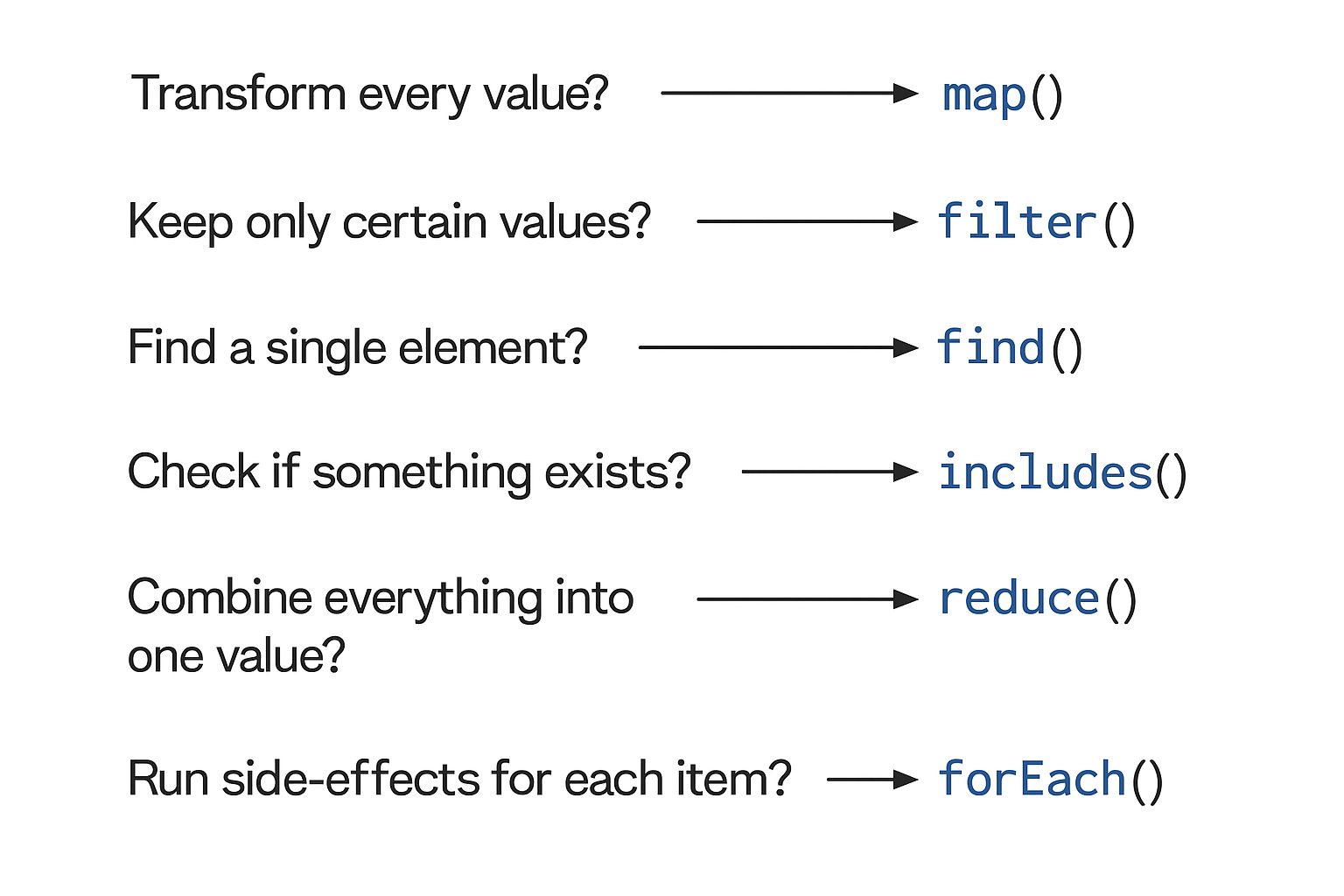6 Must-Know JavaScript Array Methods (With Simple Examples)
- 24 Nov, 2025
Javascript provides us with many array methods but only a handful are used consistently in real-world code. So in this post, we will see the 6 most essential array methods, along with simple diagrams and clear examples to make it easier and straightforward to understand.
The Main 6 Array Methods
These are the methods you’ll encounter the most when transforming, filtering, looping, and searching through collections:
| Method | What It Does | Example |
|---|---|---|
map() | Transform each item | [1,2,3].map(n => n * 2) → [2,4,6] |
filter() | Keep only elements matching a condition | [1,2,3,4].filter(n => n % 2 === 0) |
reduce() | Combine the array into a single value | [1,2,3].reduce((a,n) => a+n, 0) |
find() | Return the first matching element | users.find(u => u.id === 2) |
includes() | Check if a primitive value exists | [1,2,3].includes(2) |
forEach() | Loop for side effects | [1,2,3].forEach(console.log) |
Which Method Should You Use?
When working with arrays, it helps to think in terms of intent:

Method-by-Method Breakdown
1. map() → Transform Each Value
// map() takes your array, applies a transformation to every item, and returns a brand-new array
const numbers = [1, 2, 3];
const doubled = numbers.map(n => n * 2);
// Output: [2, 4, 6]Use it when:
- You want the same number of elements
- You’re transforming values: formatting text, adding flags, extracting fields, converting types, etc.
2. filter() → Keep Only What Matches
// filter() returns a new array containing only the elements that satisfy a condition
const evens = [1, 2, 3, 4].filter(n => n % 2 === 0);
// Output: [2, 4]Use it when:
- You’re removing unwanted items
- You’re validating or sanitizing lists
- You need a subset of the original array
3. reduce() → Accumulate Into a Single Value
// reduce() takes each value and combines it into one final output: a number, an object, an array, or any other structure
const sum = [1, 2, 3, 4].reduce((acc, n) => acc + n, 0);
// Output: 10Use it when:
- You want totals, minimums, maximums
- You’re building objects or maps
- You’re transforming data into a single result
4. find() → Get the First Matching Element
// find() returns the first element that matches your condition and stops early
const user = users.find(u => u.id === 2);Use it when:
- You expect only one match
- You want the actual object, not a filtered array
- You want the search to stop early once found
5. includes() → Check Existence
// includes() checks if a primitive value (string, number, boolean) exists inside an array
[1, 2, 3].includes(2); // trueUse it when:
- You only need a yes/no answer
- You’re checking for common values like IDs, tags, or flags
6. forEach() → Loop for Side Effects
// Use it when you’re not transforming or filtering, just doing something with each value
[1, 2, 3].forEach(n => console.log(n));Use it for:
- Logging
- Mutating existing objects
- DOM updates
- External calls (APIs, analytics, etc.)
Not recommended for building new arrays, use map() or filter() instead.
Mutating vs Non-Mutating Methods
One of the biggest pitfalls for newer developers is knowing which methods modify the original array.
| Category | Methods | Mutates? |
|---|---|---|
| ❌ Non-Mutating | map, filter, reduce, slice, concat | No |
| ✅ Mutating | push, pop, shift, unshift, splice, sort, reverse, fill | Yes |
Why it matters: mutating methods can cause hard-to-debug side effects, especially in React or functional codebases.
Quick Tips for Using Array Methods
1. Prefer non-mutating methods
They’re safer, more predictable, and play nicer with modern frameworks.
2. Method chaining: Your superpower
const total = items
.filter(x => x.active)
.map(x => x.value)
.reduce((sum, v) => sum + v, 0);3. Understand early-exit behavior
find()→ stops earlyincludes()→ stops earlyforEach()andmap()→ do NOT stop early
4. Performance basics
map,filter,forEach→ O(n)sort→ O(n log n)reduce→ O(n), but can replace multiple loops
Final Thoughts
Mastering these methods can level-up your Javascript skills and improve the quality of your code. Using these methods make your code:
- More expressive
- Less error-prone
- More maintainable
- Easier to read
Next Up: Full list of Javascript Array Methods
Don’t miss the next post where we will break down the majority of Javascript array methods.
Happy learning and thank you for reading!